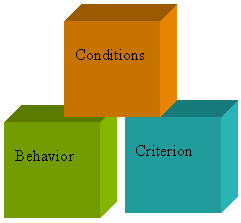
|
 |
 |
TOPICS
A. Formative vs. Summative Assessments
B. Setting Targets and Writing Objectives
C. Reliability and Validity
 |
|||||||||||||||||||
B. Setting Targets and Writing Objectives
|
|||||||||||||||||||
|
|||||||||||||||||||
Using these general target areas, teachers create specific classroom objectives that are based on state/district standards and benchmarks. Well-written objectives are made up of three building blocks -- conditions, behavior, and criterion (see below).
Figure 1. Building Blocks for Objectives. The Conditions define the materials that
will be available (or unavailable) when the objective is assessed.
It generally states what the student will be given or not
given. Example conditions for objectives might include:
The Behavior is a verb that describes an observable activity -- what the student will do. The behavior is generally stated as an action verb, such as: solve, compare, list, explain, evaluate, identify, define.
After the objectives are written, it is relatively easy to create a corresponding assessment item. For example, the first objective could be assessed with a matching exercise; the second with a short response essay question.
|
Try This |
|||
 |
|||
Continue
to Section C SITE MAP |


